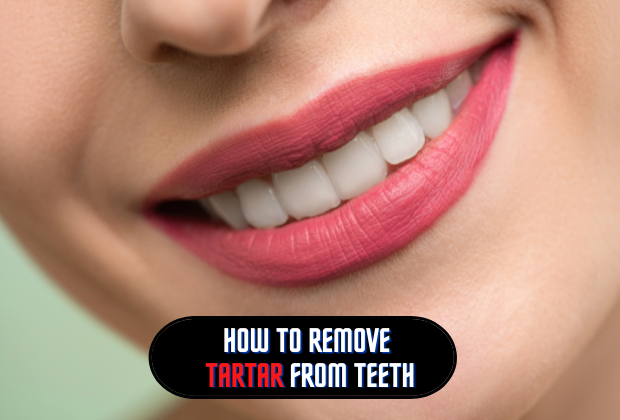Ever wonder how to remove tartar from teeth? You’ve probably heard regular dental visits and brushing your teeth regularly is the key to eliminating tartar buildup. As important as it is for your dental hygiene, most people don’t brush their teeth twice a day during the week and not at all on weekends. A better solution is to use an oral irrigator, also called a water flosser or water pic. Below are some hints on how to get rid of tartar from teeth with a water pic.

What is tartar?
Tartar, known as calculus in the medical world, is a major dental problem. It consists of calcium phosphate salt combined with plaque and bacteria. The presence of tartar on your teeth indicates that you have a higher risk of tooth decay, gum diseases and other oral problems. If not removed through a professional dental cleaning procedure, tartar can build up and cause serious oral problems.
Tartar is yellowish or brownish in color and it is formed when plaque minerals harden on the surface of the teeth. Plaque is a sticky substance that keeps building up on the surface of your teeth each day due to accumulation of food particles and bacteria in the mouth.
To remove tartar from your teeth, you need to go for a dental cleaning process at least two times every year where tartar will be scraped off from your teeth by using hand or ultrasonic instruments or laser devices. When plaque remains present on the surface of your teeth for a long period, it causes mineralization and hardens into tartar.
Tartar forms on all surfaces of your teeth including above and below your gums as well. There are some effective home remedies that can help you to prevent the accumulation of plaque and tartar on the surface of your teeth.
How to remove tartar from teeth?
The most effective way to remove tartar and get a white teeth is by having a professional cleaning at your dentist’s office. For those who don’t have access to dental care, there are other ways to remove plaque and tartar buildup at home. To prevent tartar from forming in the first place, it’s important to brush and floss your teeth regularly. Use an antibacterial mouthwash for additional protection.
Brushing properly prevents calculus
Brushing is the most important part of taking care of your teeth. There are many different ways to brush your teeth, but the best way is to use a soft-bristled toothbrush and fluoride toothpaste. The toothbrush should be big enough to fit comfortably in your mouth. You should brush your teeth at least twice a day—in the morning and before you go to bed—to clean away food and plaque. If you have braces or other dental appliances, you may need to brush more often. For tips on how to floss and rinse properly, keep reading!
Let’s look at how to properly brush your teeth:
- Hold the brush at a 45-degree angle to your gums and move it back and forth in short strokes.
- Brush the outer surfaces of your teeth and tongue as well, using the same method as above.
- To clean the inside surfaces of your front teeth, tilt the brush vertically and make several gentle up-and-down strokes with the top part of the brush.
- To clean the inside surfaces of your back teeth, tilt the brush vertically and use both up-and-down strokes and gentle circles.
Floss daily – a remedy for tartar too !
You’ve heard it before, and you’ll hear it again: flossing is good for your teeth. While it’s true that brushing alone can’t get rid of all the plaque and bacteria in your mouth, flossing is a simple way to supplement your oral hygiene routine and help maintain the health of your mouth.
But what does flossing do, exactly? The most commonly cited benefit of flossing is that it removes tartar from between teeth. Tartar is plaque that has hardened on the enamel—it can form within 48 hours of brushing, and if left untreated, can cause tooth decay or gum disease.
Flossing helps remove tartar by getting between teeth and under the gum line, where a toothbrush can’t reach. And while brushing twice a day takes care of some of this buildup, there are areas in your mouth where brush bristles just don’t fit. But there’s more to flossing than keeping tartar at bay—it also helps with bad breath (which can be caused by bacteria in your mouth), prevents cavities and gingivitis, protects against heart disease and diabetes, and can even slow down the formation of wrinkles! So give yourself a pat on the back for taking care of yourself with those
Try mouthwash
mouthwash is an excellent way to remove plaque and tartar from teeth. You can use mouthwash as your daily routine to keep your teeth clean and healthy. There are different types of mouthwashes available in the market.
You should choose a mouthwash which has the ability to kill bacteria in your teeth. When you are using mouthwash for cleaning tartar, you should know what type of mouthwash will be best for you.
There are two types of mouthwashes: therapeutic and cosmetic. Therapeutic mouthwashes destroy bacteria and prevent tooth decay. Cosmetic mouthwashes are used to freshen breath and whiten teeth.
Mouthwash [1] also reduces the amount of acid in your mouth that causes tartar buildup—and if you’re prone to dry mouth (a side effect of many medications), using alcohol-free mouthwash can keep your mouth moist and prevent the growth of bacteria that can lead to decay.
Rinse with hydrogen peroxide.
Hydrogen peroxide is a powerful antiseptic that can kill germs in your mouth, a process that helps whiten your teeth. It also removes plaque, which is the precursor to tartar and the main cause of tooth decay and gum disease. If left untreated, tartar can lead to gingivitis, a gum infection that destroys the soft tissue around your teeth. You can get rid of it by using hydrogen peroxide to rinse your teeth.
How to rinse with hydrogen peroxide
Fill a glass with 3 percent hydrogen peroxide. Dip a toothbrush into the hydrogen peroxide and brush your teeth with it. If you have sensitive gums, brush gently to avoid irritating them. Rinse your mouth when you are finished and spit out any remaining hydrogen peroxide. Repeat this procedure once daily for several weeks until plaque is no longer visible on your teeth and gums.
Limit acidic drinks
If you want to limit the amount of tartar on your teeth, then you need to avoid acidic drinks. Tartar, which is calcium phosphate, forms when plaque combines with sugar and acid in the mouth. Even though there are special toothpastes that can help prevent tartar, it is much easier to avoid it in the first place by simply limiting the amount of acidic foods and drinks that you consume. Here are a few tips for avoiding tartar.
The most common source of acid in your diet comes from soft drinks, which actually contain more acid than any other food or drink. The acid in soft drinks will break down the enamel on your teeth, which can cause cavities, cracks and other problems. If you are looking to reduce your intake of these drinks, then you should consider drinking water instead. Water contains no acids and will help keep your teeth healthy and strong.
Cut out sugary foods and drinks
Sugary foods and drinks are a major cause of tooth decay. This is because the bacteria in your mouth feed on sugar that you eat or drink. The bacteria produce acids as a result. These acids attack the enamel surface of your teeth.
The more often you consume sugary foods and drinks, the more acid attacks you get, and these repeated attacks weaken the enamel surface of your teeth over time. Eventually, the outer layer of enamel breaks down, which creates a small hole or cavity in the tooth. This allows the bacteria to get inside the tooth, where they can multiply and do more damage.
If tooth decay is left untreated, it can cause pain and eventually lead to an abscess forming around your tooth root (see below).
Bacteria also stick to pieces of food that get trapped between your teeth. Over time, this can harden into a substance called dental plaque.
Removing tartar from teeth : The Conclusion
You are now equipped with a number of techniques to eliminate tartar from your smile. Some may be more effective than others. It is important to try out different methods and find which ones work best for you. Furthermore, you may need to repeat certain steps over multiple visits in order to remove tartar build-up. Never hesitate to get help from a dentist if you feel it is taking too long to remove tartar by yourself. Your dentist likely has the tools and knowledge needed to get the job done efficiently.

Lifebing is driven by an unrelenting passion for promoting health and well-being, our team is wholly committed to curating exceptional content and immersive experiences.
